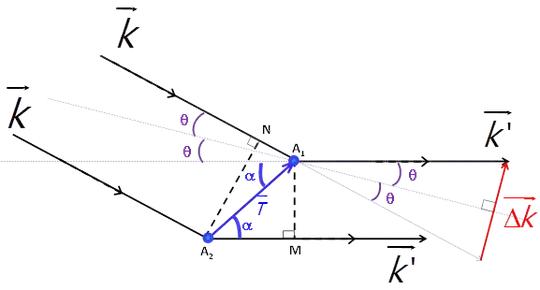The Wikipedia article for the Laue equations presents them as follows:
Let $\mathbf{a}\, ,\mathbf{b}\, ,\mathbf{c}$ be the primitive vectors of the crystal lattice $L$, whose atoms are located at the points $\mathbf x = p\,\mathbf a+q\,\mathbf b+r\,\mathbf c$ that are integer linear combinations of the primitive vectors.
Let $\mathbf{k}_{\mathrm{in}}$ be the wavevector of the incoming (incident) beam, and let $\mathbf k_{\mathrm{out}}$ be the wavevector of the outgoing (diffracted) beam. Then the vector $\mathbf k_{\mathrm{out}} - \mathbf k_{\mathrm{in}} = \mathbf{\Delta k}$ is called the "scattering vector" (also called transferred wavevector) and measures the change between the two wavevectors.
The three conditions that the scattering vector $\mathbf{\Delta k}$ must satisfy, called the "Laue equations", are the following: the numbers $h, k, l$ determined by the equations
$$\mathbf{a}\cdot\mathbf{\Delta k}=2\pi h$$ $$\mathbf{b}\cdot\mathbf{\Delta k}=2\pi k$$ $$\mathbf{c}\cdot\mathbf{\Delta k}=2\pi l$$
must be integer numbers. Each choice of the integers $(h,k,l)$, called Miller indices, determines a scattering vector $\mathbf{\Delta k}$. Hence there are infinitely many scattering vectors that satisfy the Laue equations. They form a lattice $L^*$, called the reciprocal lattice of the crystal lattice. This condition allows a single incident beam to be diffracted in infinitely many directions. However, the beams that correspond to high Miller indices are very weak and can't be observed. These equations are enough to find a basis of the reciprocal lattice, from which the crystal lattice can be determined. This is the principle of x-ray crystallography.
The same article provides the mathematical derivation as follows:
The incident and diffracted beams are planar wave excitations
$${\displaystyle f_{\mathrm {in} }(t,\mathbf {x} )=A_{\mathrm {in} }\cos(\omega \,t-\mathbf {k} _{\mathrm {in} }\cdot \mathbf {x} )}$$
$${\displaystyle f_{\mathrm {out} }(t,\mathbf {x} )=A_{\mathrm {out} }\cos(\omega \,t-\mathbf {k} _{\mathrm {out} }\cdot \mathbf {x} ).}$$
of a field that for simplicity we take as scalar, even though the main case of interest is the electromagnetic field, which is vectorial.
The two waves propagate through space independently, except at the points of the lattice, where they resonate with the oscillators, so their phase must coincide. Hence for each point
$${\displaystyle \cos(\omega \,t-\mathbf {k} _{\mathrm {in} }\cdot \mathbf {x} )=\cos(\omega \,t-\mathbf {k} _{\mathrm {out} }\cdot \mathbf {x} ),}$$
or equivalently, we must have
$${\displaystyle \omega \,t-\mathbf {k} _{\mathrm {in} }\cdot \mathbf {x} =\omega \,t-\mathbf {k} _{\mathrm {out} }\cdot \mathbf {x} +2\pi n,}$$
for some integer $n$, that depends on the point $\mathbf{x}$. Simplifying we get
$${\displaystyle \mathbf {\Delta k} \cdot \mathbf {x} =(\mathbf {k} _{\mathrm {out} }-\mathbf {k} _{\mathrm {in} })\cdot \mathbf {x} =2\pi n.}$$
Now, it is enough to check that this condition is satisfied at the primitive vectors ${\displaystyle \mathbf {a} ,\mathbf {b} ,\mathbf {c} }$ (which is exactly what the Laue equations say), because then for the other points ${\displaystyle \mathbf {x} =p\,\mathbf {a} +q\,\mathbf {b} +r\,\mathbf {c} }$ we have
$${\displaystyle \mathbf {\Delta k} \cdot \mathbf {x} =\mathbf {\Delta k} \cdot (p\,\mathbf {a} +q\,\mathbf {b} +r\,\mathbf {c} )=p\,2\pi h+q\,2\pi k+r\,2\pi l=2\pi (hp+kq+lr)=2\pi n,}$$
where $n$ is the integer ${\displaystyle hp+kq+lr}$.
This ensures that if the Laue equations are satisfied, then the incoming and outgoing wave have the same phase at all points of the crystal lattice, so the oscillation of the atoms, that follows the incoming wave, can at the same time generate the outgoing wave.
There are two points that I am unclear on:
-
The two waves propagate through space independently, except at the points of the lattice, where they resonate with the oscillators, so their phase must coincide.
What is meant by "except at the points of the lattice, where they resonate with the oscillators"? What oscillators is it referring to? And how is this exceptional case represented mathematically (that is, how is it represented differently to the typical situation)?
-
$${\displaystyle \omega \,t-\mathbf {k} _{\mathrm {in} }\cdot \mathbf {x} =\omega \,t-\mathbf {k} _{\mathrm {out} }\cdot \mathbf {x} +2\pi n,}$$
Why is $2\pi n$ being added here? I realise that $\varphi = \omega \,t-\mathbf{k}_{\mathrm {out}} \cdot \mathbf{x}$ is the phase of the wave, but I'm not totally clear on why $2\pi$ was added.
I would appreciate it if people would please take the time to clarify these two points.
EDIT
I think I have found the answer to my second question. In a section on the Laue equations, my textbook says the following:
Constructive interference will occur in a direction such that contributions from each lattice point differ in phase by $2\pi$.
So would I be correct in thinking that the addition of $2\pi n$ is due to constructive interference? And I'm assuming that this is also true for integer multiples of $2\pi$ (so $2\pi n$), right?
